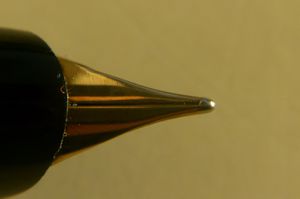Differenze tra le versioni di "Tines"
Jump to navigation
Jump to search

| Riga 1: | Riga 1: | ||
[[File:Aurora-88P-Nib.jpg|thumb|The tines of an [[Aurora 88P]] hooded nib]] | [[File:Aurora-88P-Nib.jpg|thumb|The tines of an [[Aurora 88P]] hooded nib]] | ||
| − | They are usually called "tines" the two sides in which of the [[slit]] divides the nib tip. Typically their extension goes from the air hole to the iridium tip, and it is thanks to their separation that flexible nibs are able to exert a stroke variation. For a good operation of the nib the tines should be well aligned with each other vertically so that the two sides of the tip are well adjacent. | + | They are usually called ''"tines"'' the two sides in which of the ''[[slit]]'' divides the [[nib]] tip. Typically their extension goes from the air hole to the iridium tip, and it is thanks to their separation that flexible nibs are able to exert a stroke variation. For a good operation of the nib the ''tines'' should be well aligned with each other vertically so that the two sides of the tip are well adjacent. |
[[Category:Glossary]] | [[Category:Glossary]] | ||
[[Category:Technology]] | [[Category:Technology]] | ||
[[Category:Translated Pages]] | [[Category:Translated Pages]] | ||
Versione delle 12:33, 13 lug 2014

The tines of an Aurora 88P hooded nib
They are usually called "tines" the two sides in which of the slit divides the nib tip. Typically their extension goes from the air hole to the iridium tip, and it is thanks to their separation that flexible nibs are able to exert a stroke variation. For a good operation of the nib the tines should be well aligned with each other vertically so that the two sides of the tip are well adjacent.